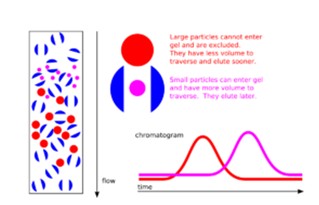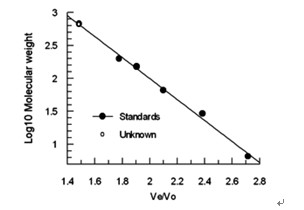
GPC stands for Gel permeation chromatography which is a separation technique based on hydrodynamic volume (size in solution). Molecules are separated from one another based on differences in molecular size. This technique is often used for polymer molecular weight determination.
GPC is accomplished by passing the sample through a porous media. Larger molecules can not access some of the pores and exit the column more rapidly. Smaller molecules penetrate into more of the porous structure and elute at longer retention times. Figure 1 shows an example of this process and the path which two molecules of different size take when passing through a GPC column. The red molecule can not fit within the pores of the gel while the pink molecule fits into all the pores of the gel increasing the time required to pass through the column. It is this filtration effect which causes separation by size. Figure 2 shows an example of the instrumentation used to accomplish a GPC separation.

Figure 1: Two molecules of different size pass through a GPC column.

Figure 2: A size exclusion column
GPC is the most commonly used method for polymer molecular weight and polydispersity index. This process is done by first analyzing a series of standards of known molecular weight. The retention time for these standards is then used to create a calibration curve. Figure 3 shows an example of this process in which standards were run and the resulting retention time used to make the calibration curve. The retention time for an unknown material can then be determined based on the retention volume at which it elutes.

Figure 3: Standardization of a size exclusion column

 .
.